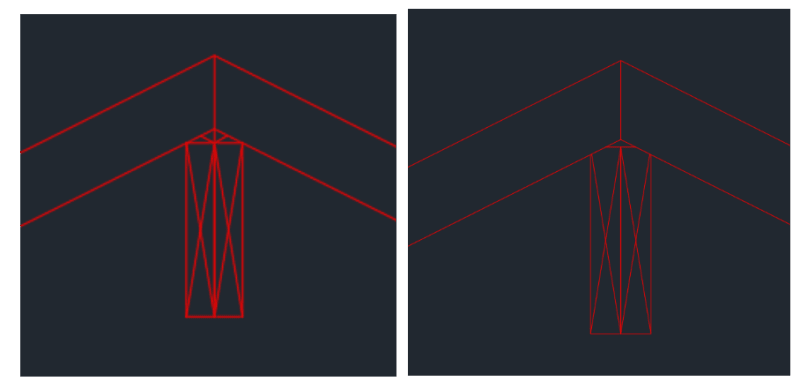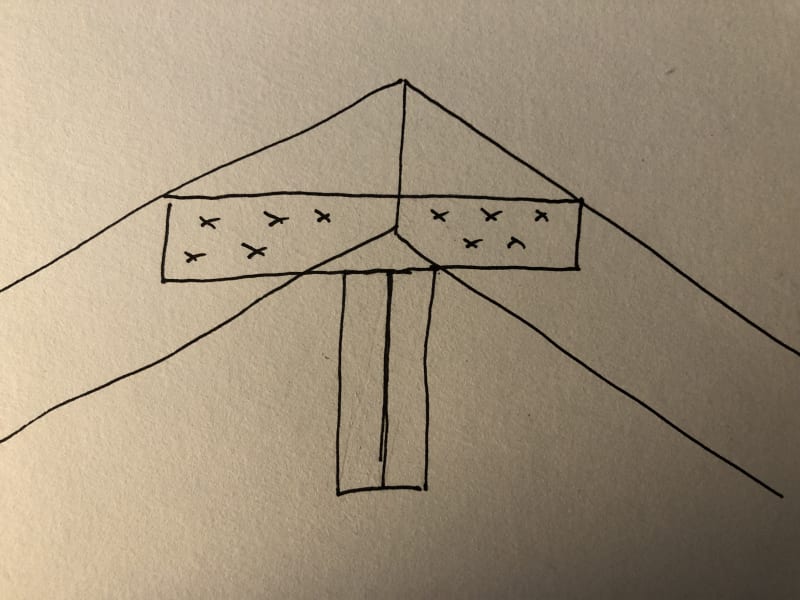Navigation
Install the app
How to install the app on iOS
Follow along with the video below to see how to install our site as a web app on your home screen.
Note: This feature may not be available in some browsers.
More options
Style variation
-
Congratulations TugboatEng on being selected by the Eng-Tips community for having the most helpful posts in the forums last week. Way to Go!
You are using an out of date browser. It may not display this or other websites correctly.
You should upgrade or use an alternative browser.
You should upgrade or use an alternative browser.
New Ridge Beam Detail 1
- Thread starter jayson34
- Start date
- Status
- Not open for further replies.
DoubleStud
Structural
You can do either. You can bird mouth the rafters if they are 2x12. If I-Joist you do detail on the left. Don't forget the blocking between rafters. Make sure you have a load path. For example blocking toe nailed to rafters, blocking toe nailed to ridge beam. If you have a wedge above the ridge, make sure there is still load path and not terminate at the wedge.
jerseyshore
Structural
Did anyone suggest a bird mouth rafter yet?
- Thread starter
- #5
I would go with the 2nd detail with the top of the ridge cut to match the rafter pitch. Add blocking between the rafters above the beam, as noted above. Also provide a connection between the rafters and new ridge to resist uplift.
If you’re also the builder, use a test piece to ensure you get the beam cut correct.
If you’re also the builder, use a test piece to ensure you get the beam cut correct.
-
1
- #8
Eng16080 the OP says that the rafters are existing so using the table saw to get an angle on the ridge beam members will likely result in the need to shim anyways. There is no way that the rafters of an existing shed are true along the length of the shed.
IMHO for existing construction the left detail makes more sense. Put the beams up and securely pack as required to achieve bearing. Add CFS straps if needed for uplift.
IMHO for existing construction the left detail makes more sense. Put the beams up and securely pack as required to achieve bearing. Add CFS straps if needed for uplift.
Enable, I agree there will need to be some adjustment considering that the rafters are existing. Still, I would use the approach mentioned above. Specifically, I would:
[ol 1]
[li]Try to get an accurate measurement of the roof pitch.[/li]
[li]Cut a test piece (something light) like a double 2x4 with the opposing slopes cut along the top.[/li]
[li]Check the test piece cut, and make minor adjustments as needed.[/li]
[li]Cut the actual ridge beam based on the adjusted cut of the test piece.[/li]
[li]Shim if necessary and/or jack up slightly (only slightly) to close any small gaps.[/li]
[li]Add blocking and uplift straps if necessary.[/li]
[/ol]
For me, this is how I would likely approach it. Cutting several birdsmouths seems like more work. The cut itself would be a pain. Cutting out the little triangle chunks would require either using an oscillating multi-tool or drilling a hole at the inside corner and removing the remainder with a jig-saw or similar all while up on a ladder. Assuming that the rafters are not true along the length (which they likely aren't), some of the birdsmouth cuts will need to be deeper than others as well for a tight fit, or shimming will be required.
I might also consider option 1 without shims if the loads are very light and crushing of the wood fibers at the sharp edge isn't a concern. Or if the loads are more moderate, I might consider the same except with a Simpson VPA connector or perhaps just an angle (L90 or similar) attached to the face of the beam along one leg and the face of the rafter along the other.
[ol 1]
[li]Try to get an accurate measurement of the roof pitch.[/li]
[li]Cut a test piece (something light) like a double 2x4 with the opposing slopes cut along the top.[/li]
[li]Check the test piece cut, and make minor adjustments as needed.[/li]
[li]Cut the actual ridge beam based on the adjusted cut of the test piece.[/li]
[li]Shim if necessary and/or jack up slightly (only slightly) to close any small gaps.[/li]
[li]Add blocking and uplift straps if necessary.[/li]
[/ol]
For me, this is how I would likely approach it. Cutting several birdsmouths seems like more work. The cut itself would be a pain. Cutting out the little triangle chunks would require either using an oscillating multi-tool or drilling a hole at the inside corner and removing the remainder with a jig-saw or similar all while up on a ladder. Assuming that the rafters are not true along the length (which they likely aren't), some of the birdsmouth cuts will need to be deeper than others as well for a tight fit, or shimming will be required.
I might also consider option 1 without shims if the loads are very light and crushing of the wood fibers at the sharp edge isn't a concern. Or if the loads are more moderate, I might consider the same except with a Simpson VPA connector or perhaps just an angle (L90 or similar) attached to the face of the beam along one leg and the face of the rafter along the other.
Or yet another option:
Go with option 1, with no shims, and run a horizontal piece (2x4, 2x6, or whatever) with the bottom edge set on top of the ridge beam with the face attached to the side of the existing rafters.
Now that I'm thinking it out, I think this would be my preferred approach.
Go with option 1, with no shims, and run a horizontal piece (2x4, 2x6, or whatever) with the bottom edge set on top of the ridge beam with the face attached to the side of the existing rafters.
Now that I'm thinking it out, I think this would be my preferred approach.
- Thread starter
- #13
Per code requirement, the end of the rafter needs a minimum bearing length. Bird mouth provides a flat surface while these details provide a sloped surface. I think option one is the way to go - set up the beam first, and shim at each rafter locally to ensure bearing. Toe nails should be sufficient for the stability of gravity support, as the collar ties will not be removed. Thanks everyone.
SWComposites
Aerospace
If its a “small shed”, why is such a large ridge beam needed? Is the shed big enough to require it to be engineered?
Enable said:the OP says that the rafters are existing
I missed the point about the rafters being existing. It would be the first time I missed critical data in a problem statement.
If the rafters are existing is there a 2x ridge board? If so, why not just attach the new ridge beam to the bottom of the ridge board with Simpson LTP4s, A-34s, etc?'
Otherwise, I like the collar tie detail as presented by Eng16080 and suggested by XR250.
DoubleStud
Structural
oh, it is just a shed? It will probably fine without anything lol. The double top plates and the perpendicular wall will take care of the thrust.
jerseyshore
Structural
My guess is it's an old shed, hence the no ridge nailer shown, and the owner doesn't want to have any collar or rafter ties so OP is designing a ridge beam.
I'd probably show detail 1, they can take a 2x4 or 4x4 and rip it down.
This does feel like one of those details that no matter what you show the framer will do the opposite, so I wouldn't worry about it too much.
I'd probably show detail 1, they can take a 2x4 or 4x4 and rip it down.
This does feel like one of those details that no matter what you show the framer will do the opposite, so I wouldn't worry about it too much.
- Status
- Not open for further replies.
Similar threads
- Replies
- 11
- Views
- 1K
- Replies
- 2
- Views
- 2K
- Replies
- 5
- Views
- 4K
- Replies
- 13
- Views
- 4K


